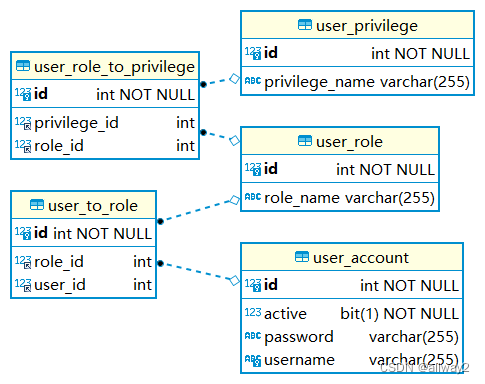- 1使用LSTM和ResNet的无监督多模态分类_resnet lstm
- 2elementui校验踩坑_el-form validator不触发
- 32024-02-11 Unity 编辑器开发之编辑器拓展2 —— 自定义窗口
- 4linux脚本打开文件任意行,shell脚本语言(超全超详细)
- 5支付宝支付的实现【沙箱】(学习笔记)_支付宝沙箱支付移动端(android原生)
- 6微信小程序真机调试,苹果用户记得打开本地网络_request:fail errcode:-109 cronet_error_code:-109 e
- 7基于安卓/微信小程序的个人健康打卡系统_健康打卡管理系统
- 8Python初学者如何系统的学习python————Python入门学习指南--内附学习路径_python系统学习
- 9redistemplate是如何在springboot中自动配置的_lettuceconnectionfactory没有自动注入
- 10AI:141-利用自然语言处理改进医疗信息提取与分类
Spring Security 中的RBAC角色和权限_spring security rabc
赞
踩
在这篇文章中,我们将看看使用 Spring boot的R ole B ased A ccess Control ( RBAC )。
了解 RBAC
在 RBAC 模型中存在三个关键实体。他们是,
- 用户或主题 ——执行操作的系统参与者。它可以代表一个自然人、一个自动帐户,甚至是另一个应用程序。
- 角色 ——由职位、部门或职能层次结构定义的权限级别。
- 特权——执行操作的批准或许可
话虽如此,以下是这些实体如何相互映射的说明。

基本上,用户可以执行操作。要执行操作,他们需要具有一定的权限或特权。这就是为什么将权限分配给角色而将角色分配给用户的原因。让我们看看如何实现这些。
RBAC 实体
让我们创建上述对象以表示为数据库实体。
用户实体
- @Data
- @Entity
- public class UserAccount {
- @Id
- @GeneratedValue(strategy = GenerationType.IDENTITY)
- private Integer id;
- @Column(unique = true)
- private String username;
- private String password;
- private boolean active;
- @OneToMany(mappedBy = "user")
- private List<UserToRole> userToRoles;
- }
用户角色实体
- @Data
- @Entity
- public class UserRole {
- @Id
- @GeneratedValue(strategy = GenerationType.IDENTITY)
- private Integer id;
- private String roleName;
- @OneToMany(mappedBy = "role")
- private List<UserRoleToPrivilege> userRoleToPrivileges;
- }
UserPrivileges 实体
- @Data
- @Entity
- public class UserPrivilege {
- @Id
- @GeneratedValue(strategy = GenerationType.IDENTITY)
- private Integer id;
- private String privilegeName;
- }
UserRoleToPrivilege 实体
- @Data
- @Entity
- public class UserRoleToPrivilege {
- @Id
- @GeneratedValue(strategy = GenerationType.IDENTITY)
- private Integer id;
- @ManyToOne
- private UserRole role;
- @ManyToOne
- private UserPrivilege privilege;
- }
UserToRole 实体
- @Data
- @Entity
- public class UserToRole {
- @Id
- @GeneratedValue(strategy = GenerationType.IDENTITY)
- private Integer id;
- @ManyToOne
- private UserAccount user;
- @ManyToOne
- private UserRole role;
- }
自动生成的数据库ER图
pom.xml
- <?xml version="1.0" encoding="UTF-8"?>
- <project xmlns="http://maven.apache.org/POM/4.0.0" xmlns:xsi="http://www.w3.org/2001/XMLSchema-instance"
- xsi:schemaLocation="http://maven.apache.org/POM/4.0.0 https://maven.apache.org/xsd/maven-4.0.0.xsd">
- <modelVersion>4.0.0</modelVersion>
- <parent>
- <groupId>org.springframework.boot</groupId>
- <artifactId>spring-boot-starter-parent</artifactId>
- <version>2.7.4</version>
- <relativePath/> <!-- lookup parent from repository -->
- </parent>
- <groupId>com.springhow.examples.springboot</groupId>
- <artifactId>spring-boot-security-rbac</artifactId>
- <version>0.0.1-SNAPSHOT</version>
- <name>spring-boot-security-rbac</name>
- <description>Demo project for Spring Boot</description>
-
- <properties>
- <java.version>1.8</java.version>
- </properties>
-
- <dependencies>
- <dependency>
- <groupId>org.springframework.boot</groupId>
- <artifactId>spring-boot-starter-data-jpa</artifactId>
- </dependency>
- <dependency>
- <groupId>org.springframework.boot</groupId>
- <artifactId>spring-boot-starter-web</artifactId>
- </dependency>
- <dependency>
- <groupId>org.springframework.boot</groupId>
- <artifactId>spring-boot-starter-security</artifactId>
- </dependency>
- <dependency>
- <groupId>org.projectlombok</groupId>
- <artifactId>lombok</artifactId>
- </dependency>
- <dependency>
- <groupId>mysql</groupId>
- <artifactId>mysql-connector-java</artifactId>
- <scope>runtime</scope>
- </dependency>
- <dependency>
- <groupId>org.springframework.boot</groupId>
- <artifactId>spring-boot-starter-test</artifactId>
- <scope>test</scope>
- </dependency>
- </dependencies>
-
- <build>
- <plugins>
- <plugin>
- <groupId>org.springframework.boot</groupId>
- <artifactId>spring-boot-maven-plugin</artifactId>
- </plugin>
- </plugins>
- </build>
-
- </project>

application.properties
- ##################################################
- # define mysql DataSource properties
- spring.jpa.hibernate.ddl-auto=update
- spring.datasource.url=jdbc:mysql://localhost:3306/rbac?autoReconnect=true&useSSL=false&useUnicode=true&characterEncoding=UTF-8&serverTimezone=Asia/Shanghai
- spring.datasource.username=root
- spring.datasource.password=root
- spring.datasource.driver-class-name =com.mysql.cj.jdbc.Driver
- spring.jpa.show-sql: true
-
- ##################################################
- # Thymeleaf
- #spring.thymeleaf.cache=false
- #spring.thymeleaf.prefix=classpath:/templates
- #spring.thymeleaf.suffix=.html
填充数据库条目
有了上述实体,让我们用适当的角色和权限填充数据库。对于这个测试,我使用 data.sql 文件直接输入了条目。
- insert into user_account(id, username, password, active) values (1, 'user1', '{noop}user1', 1);
- insert into user_account(id, username, password, active) values (2, 'user2', '{noop}user2', 1);
- insert into user_account(id, username, password, active) values (3, 'admin', '{noop}admin', 1);
- insert into user_role(id, role_name) values (1, 'USER');
- insert into user_role(id, role_name) values (2, 'ADMIN');
- insert into user_to_role(id, user_id, role_id) values (1, 1, 1);
- insert into user_to_role(id, user_id, role_id) values (2, 2, 1);
- insert into user_to_role(id, user_id, role_id) values (3, 3, 2);
- insert into user_privilege(id, privilege_name) values (1, 'canReadUser');
- insert into user_privilege(id, privilege_name) values (2, 'canReadAdmin');
- insert into user_role_to_privilege(id, role_id, privilege_id) values (1, 1, 1);
- insert into user_role_to_privilege(id, role_id, privilege_id) values (2, 2, 1);
- insert into user_role_to_privilege(id, role_id, privilege_id) values (3, 2, 2);
请注意,我使用的是
NoOpPasswordEncoder,因为密码前面带有{noop}.
Spring Security userDetailsService
在我们之前的帖子中,我们总是使用一个角色来调用 USER 系统中的所有用户。但是,我们需要进行更改以从数据库中选择这些角色和权限。这是一个如何做到这一点的粗略示例。
- @Component
- public class DatabaseUserDetailsService implements UserDetailsService {
-
- private final
- UserAccountRepository userAccountRepository;
-
- public DatabaseUserDetailsService(UserAccountRepository userAccountRepository) {
- this.userAccountRepository = userAccountRepository;
- }
-
- @Override
- public UserDetails loadUserByUsername(String username) throws UsernameNotFoundException {
- UserAccount userAccount = userAccountRepository.findByUsername(username);
- if (userAccount == null) {
- throw new UsernameNotFoundException("User with username [" + username + "] not found in the system");
- }
-
- Set<GrantedAuthority> authorities = new HashSet<>();
-
- for (UserToRole userToRole : userAccount.getUserToRoles()) {
- authorities.add(new SimpleGrantedAuthority("ROLE_" + userToRole.getRole().getRoleName()));
- for (UserRoleToPrivilege userRoleToPrivilege : userToRole.getRole().getUserRoleToPrivileges()) {
- authorities.add(new SimpleGrantedAuthority(userRoleToPrivilege.getPrivilege().getPrivilegeName()));
- }
- }
-
- return new CustomUserDetails(userAccount.getUsername(), userAccount.getPassword(), userAccount.isActive(), authorities);
- }
- }

这里要注意的一件有趣的事情是,我们添加了角色和权限作为权限。但是,所有角色都以
ROLE_. 这种特定的方式是由于安全表达式的喜欢hasRole和hasAuthority工作方式。这样,开发人员可以使用表达式为 url 映射设置角色级别和权限级别设置,您将在下面看到。
保护 API 端点
使用 WebSecurityConfigurerAdapter,您可以自定义谁可以访问哪个 URL。看看这个配置片段。
- @Configuration
- public class SecurityConfig extends WebSecurityConfigurerAdapter {
-
- protected void configure(HttpSecurity http) throws Exception {
- http.authorizeRequests()
- .antMatchers("/user").access("hasAuthority('canReadUser')")
- .antMatchers("/admin").access("hasAuthority('canReadAdmin')")
- .anyRequest().authenticated()
- .and().httpBasic()
- .and().formLogin();
- }
- }
在这里, admin 用户可以同时访问 /user 和 /admin 因为 ADMIN 角色同时拥有 canReadUser 和 canReadAdmin 权限。但是, user1 或者 user2 无法访问 /admin ,因为他们会得到 403 Forbidden 响应。
有了以上所有内容,让我们测试结果。
- $ curl -i -u "user1:user1" http://localhost:8080/user
- HTTP/1.1 200
- Set-Cookie: JSESSIONID=9BEC44655277BBDF6832817AFF4CAAA1; Path=/; HttpOnly
- X-Content-Type-Options: nosniff
- X-XSS-Protection: 1; mode=block
- Cache-Control: no-cache, no-store, max-age=0, must-revalidate
- Pragma: no-cache
- Expires: 0
- X-Frame-Options: DENY
- Content-Type: text/plain;charset=UTF-8
- Content-Length: 11
- Date: Tue, 29 Dec 2020 15:16:57 GMT
-
- Hello user!
- $ curl -i -u "user1:user1" http://localhost:8080/admin
- HTTP/1.1 403
- Set-Cookie: JSESSIONID=0910F6115CB28A9DF914D22052396448; Path=/; HttpOnly
- X-Content-Type-Options: nosniff
- X-XSS-Protection: 1; mode=block
- Cache-Control: no-cache, no-store, max-age=0, must-revalidate
- Pragma: no-cache
- Expires: 0
- X-Frame-Options: DENY
- Content-Type: application/json
- Transfer-Encoding: chunked
- Date: Tue, 29 Dec 2020 15:17:28 GMT
-
- {
- "timestamp" : "2020-12-29T15:17:28.537+00:00",
- "status" : 403,
- "error" : "Forbidden",
- "message" : "",
- "path" : "/admin"
- }

如您所见,当 user1 尝试访问 /admin 端点时,他们会收到 403 - Forbidden 消息。
这是供您学习本教程的GitHub 存储库。



